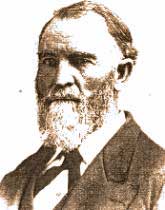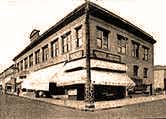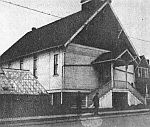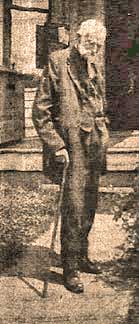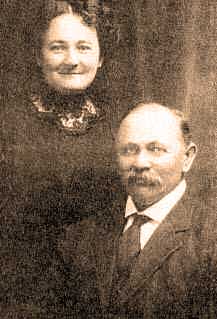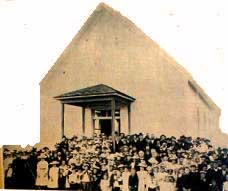 Churches of Christ & Christian Churches in the Pacific Northwest CLARK COUNTY, WASHINGTON |
 by Charles Dailey College index |
Battle Ground
Hockinson |
LaCenter |
Maple Grove |
Vancouver |
Washougal |
PL
Next Chapter . . .
Pioneer Menu . . .
Search
- - Oldest presented first.
Clark County was named in honor of Captain William Clark of the Lewis and Clark Expedition. Before Washington Territory was mapped out, it was part of the Oregon Territory that reached to the border with Canada.Brush Prairie Map
Among the oldest congregations of the Churches of Christ / Christian Churches in Clark County was the Brush Prairie congregation, established by the very effective Mac Waller, then of Monmouth, Oregon. They reported 70 members in 1876, making it the largest Stone-Campbell related church in Washington at the time. In the records of the Brush Prairie Baptist Church a line describes the defection of one respected member with the comment, "Gone to the Campbellites."
Mac Waller
Courtesy of Polk County
Historical SocietyThe church met in a log cabin, also used for a school house, on the southeast corner of 117th Avenue and 144th Street. It was probably named the Center school house.
There is a profile of Mac Waller.
Also, Mr. Waller discusses his adventures in Brush Prairie in his Reminisciences, beginning in chapter 21.Samuel C. Espy reported in July of 1879 that he preached in Brush Prairie and two were added by baptism.
S. C. Harris of the congregation wrote to the Pacific Christian Messenger in May of 1880:
I would say the congregation at this place is enjoying reasonable prosperity, have social meeting on every fourth and second Lord's days in each month, and Bro. J. Campbell, of Hillsboro, preaches for us on every 5th Lord's day, and is giving good satisfaction. Our house is crowded to its utmost capacity on the days of his meetings. It puts us in mind of the good old days of Bro. H. M. Waller's preaching for us here.Robert Campbell, writing in the Pacific Christian Messenger of November 19, 1880 said that Robert Milne was to work with this congregation for a year. Milne may have served both Brush Prairie and LaCenter.
Campbell, himself a skillful proclaimer writes,
Bro. Milne is a man of long experience in proclaiming the Gospel of peace. He speaks earnestly, clearly and forcibly. In short, if you hear him once and fail to learn something profitable unto godliness, it is your fault.Mac Waller returned for a gospel meeting in 1885, accompanied by his daughters, Etta and Ida.Over time, the congregation diminished. By 1892 the church reported just 25 members.
Among the members of the church was Samuel Cornelius Harris. He became a Justice of the Peace in Brush Prairie and owned a general store. His obituary in a Vancouver paper says: "Elder S. C. Harris of Brush Prairie was one of the best known Clark Co. pioneers, and will be missed by many, as a man of thorough integrity and good principle."
Another member was George T. Turnbull (aka George T. Bull). He married Mary Elizabeth Harris, a daughter of S. C. Harris, in 1865. They settled at Brush Prairie, and they were there in time to be listed in the 1870 census.
Jesse and Mary Holbrook were also members. At the time of the 1870 census he was 44 and she was 40. Their older children were born in Kansas and Kentucky, but their 4-year-old was born in WT. So they evidently arrived soon after the end of the Civil War. He was still living in Brush Prairie and was a subscriber to the American Christian Review in 1886-87.
The last three paragraphs are from the private papers of Dr. Jerry Rushford.Vancouver Map
Vancouver is the oldest continuously inhabited white settlement in the state, dating from 1825 when Dr. John McLoughlin settled here. It was named in honor of British explorer George Vancouver.
Geoghegan's Hall
(upstairs) still stands
at the SE corner of
7th and Main.The earliest record of restoration preaching in Vancouver is that of Mac Waller. The Vancouver Independent reported in 1876:
The Rev. Mr. Waller, a Christian preacher from Oregon, preached in the City Hall last Sunday. Mr. Waller's own comments are on this link.This events seems to match with the trip to conduct a protracted meeting in Brush Prairie described under that heading at the top of this page.
Early Ministers:
Underlined names
lead to personal profiles.Mr. Warrent
E. C. Sanderson
F. A. Powell
A. D. Skaggs
1890
1892
1901 - 1905There is also record of preaching at Vancouver in 1878. According to William Barker, a resident of Fern Prairie, the preacher was circuit-riding Samuel C. Espy. Mr. Barker wrote his observations to the The Evangelist and Record.
The present First Christian Church in Vancouver began meeting in 1881 with members who had moved to Clark County from the midwest. They rented the Geoghegan's Hall (pronounced Gay-gans), engaged an evangelist and began a revival meeting with Bruce Wolverton and James Campbell. (Wolverton was principal of the Dayton, WA High School.) There were a number of conversions, all being baptized in the Columbia River, near the railroad bridge. A Mr. Warrent, traveling from Hillsboro, Oregon, served as one of the first ministers according to historian Orval Peterson.
Other revival meetings were held including one in 1890 by Eugene C. Sanderson. The church was officially organized with 54 members with leadership from Sanderson on December 23, 1890. Their first building, at 13th and Grant, was dedicated in 1892 by Jacob Eshelman of North Yakima. F. A. Powell was the first resident minister. The congregation sponsored a debate on "Is there a Supreme Being?" in 1896.
First Building The photo is from the research of Mark Wilton: elder, researcher and aspiring minister.
Other early ministers include A. B. Wade, G.D. Sellars, and E.A. Price. These men served in Vancouver prior to 1900. A. D. Skaggs was minister of the congregation from 1901 - 1905. Use the search engine to locate his photo.
G. D. Sellars
A building was constructed on West 13th across the from the intersectiion with Grant Street. A revival meeting had an attendance of 350 in 1912. Later the building was sold to the Seventh Day Adventists and the church met in the Clark County Court House until their new building was completed at 19th and Main in 1925.
Lillian Pulley, daughter of pioneer John C. Thornton and granddaughter of William C. Thornton, remembers attending church in the temporary quarters at the County Court House when she graduated from high school in 1924. The choir sang from the jury box and the minister, D. D. Dick, preached from the judge's bench.
This writer spent 35 years leading the Minnehaha Church of Christ in Vancouver. The first Independent church in the city that used the instrument, it was established by B.L. Turner, now of Key Communications in Portland. The church is presently under the leadership of the elders. The church is located at 54th Street and St. Johns Boulevard.
The writer is again on the staff of the Minnehaha Church as Minister of Missions.
The focus of this website is on the history of the Churches of Christ and Christian Churches. However, we have come into possession a photo of the Salmon Creek United Methodist Church that dates to about 1908. The building was not new at the time of the picture, having been built in 1900. The dirt road is now US 99. The shed at the right was probably for horses that brought their owners to church.
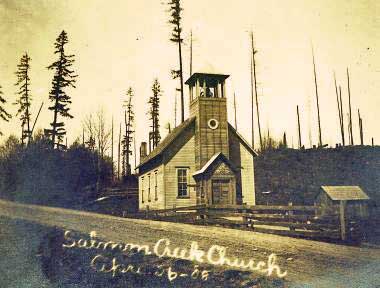
The building is still in use today for weddings and special occasions. The bell tower has been modified.
LaCenter Map
This one-time river port was originally known as Timmen's Landing. Its early developers saw it as the center for commerce in the area. Hence the name.
The first preaching by a man connected with the Restoration Movement is recorded in the Vancouver Independent of 1876. A subscriber from LaCenter writes:
A protracted meeting was commenced . . . at the Meeker school house, led by a Campbellite or Christian minister from Oregon.
Samuel C. Espy
50 years after he
lived in Clark County.This could have been the work of Samuel C. Espy, recently moved from Tillamook, Oregon. We know that Espy and his wife Miranda Harris Espy were located there by the next year. In 1879, Espy wrote to the Pacific Christian Messenger:
At the meeting of the Disciples of Christ in Lacenter, on Lord's day, July 13th, there was one addition to the church by confession and baptism.Mr. Espy was from Corsica, Pennsylvania where he had served on the city council. He then traveled to Iowa where he married Miranda (or Maranda). Their son Orville was born in Iowa before they moved to Tillamook, Oregon, where Espy was county sheriff. Orville was 16 when they lived in LaCenter.Yours in one hope,
S. C. ESPY
More information is available from the 1870 Tillamook census where he is listed as a laborer. In a discussion with the sheriff's office, it was established that he became sheriff.A family tragedy happened to the Espy's in 1877 due to diptheria. First their eleven-year-old daughter died, and five days later, their eight-year-old son died.
This funeral notice reveals a La Center family that lost all of their children:
In La Center, Clarke County, W.T., May 3d, 1877, of that dreadful disease, diphtheria, Francis N., son of Fred C. and Leonora F. Banzar, aged 1 year, 2 months and 13 days.Mr. Espy presented the following verse at the memorial:At the same place, of the same disease, May 6th, 1877, Edith A., daughter of Fred C. and Lenora F. Banzar, aged 2 years, 6 months and 21 days. (In just four days, the home of Mr. Banzar was left childless and cheerless).
Oh, little sunbeams! Oh, sweet little flowers!
That vanished and faded away in an hour.
How dark are our hearts, of thy brightness bereft!
How cheerless the home thou hast so early left.
Cheerless and dark would our life be indeed,
Save that in God's word we the promises heed,
Which bids us hope, that in years yet to come,
We will meet in the bright and glorious home.
S. C. Espy
The Vancouver Independent, Friday May 11, 1877.In his history of the Disciples of Christ, Orval Peterson reports on one M. Buchanan of LaCenter that distributed gospel tracts. Nothing more is known of his work.
Among the founding members at LaCenter were Magilbra and Caroline Anderson. They came overland to Oregon and then settled near LaCenter in 1864-1865. Caroline was a preacher's daughter from Union County, Illinois. One record says her father was as "Campbellite" minister named John Williams.
A grandson wrote, "My memory of Grandma Caroline Anderson is all super good, a beautiful, cultured, sweet, gentle and very, very refined lady, whose saintliness has come down to all of us -- her grandchildren."
Of Magilbra he wrote, "I can see him now with his bowed head, and hands folded in his lap, all of us around the table in the same reverential positions -- a Christian home -- it was perfection for fifty years. Now I carry this memory in my heart."

Caroline
AndersonMagilbra
AndersonCourtesy of Kent Anderson Later, their son Curtis and his wife Grace were attending the Woodland Christian Church, so the LaCenter Church did not last many years. The members included Reuben Thurston Lockwood and his wife, Mary Crane (Bryant) Lockwood. Mr. Lockwood, from Vermont, was postmaster at Lincoln, about two miles north of LaCenter, in 1867. Their son Sumner attended Christian College in Monmouth and then taught in the one-room Lee Lewis School in Woodland.
Fern Prairie Map
Located aout three miles north of Camas, Washington, the reason for naming the community is easy to establish. However, the ferns are all gone now.
The community was in place before Camas and had its own post office beginning in 1878.
Local resident William Barker reported a church of eight members and he was the elder in 1878. That is a good-sized congregation when the population was only 46. Aside from Mr. Barker's report to the Record and Evangelist, we have no record of this congregation. Samuel C. Espy was the circuit-riding preacher. Other churches on his circuit that year were Vancouver, Brush Prairie and La Center.
William Barker was probably 25-year-old William O. Barker and his wife was 23-year-old Lena Barker. By the time of the 1880 census, they had a son whom they named William H. Barker.
It is nearly certain that the church did not own a building, but met in a public place such as a school house, or even in private homes.
Disciple historian Orval Peterson does not include Fern Prairie as the location of a church in Clark County in his 1897 list, although he was aware of Battle Ground, Brush Prairie, Hayes, La Center, Maple Grove and Vancouver. The church may have ceased meeting by then.
Among the earliest group of disciples meeting in Clark County were those in the Maple Grove district, just south of present-day Battle Ground. Church planter S. C. Espy, mentioned above, was leading that church as early as 1879. He was living in Clark County during the 1880 census.
They built at 199 Street and 132 Avenue. It was the first Protestant church in the vicinity of Battle Ground. Their building burned in 1910 and the group merged with the developing Christian Church at Battle Ground by 1920.
In its 1982 history, the Battle Ground Community Church (United Methodist) claims the church at 199 Street and 132 Avenue was the Maple Grove Methodist Church. It is possible that S. C. Espy preached there, emphasizing the church of the New Testament order. Their eventual merger with the Battle Ground Christian Church following the 1910 fire points that direction.Battle Ground MapDisciples Historian Orval Peterson lists this as a Disciple-related church in his 1897 listing of churches.
The existence of the church in Battle Ground, Clark County, has long gone from living memory, just like Maple Grove. The first retail store was built here in 1886.
Peter and Ida Brown Onsdorff Records show a church of the New Testament order meeting in Battle Ground before 1897. A key man in those earliest days was Swedish-born Peter Onsdorff, a leading man in business, school, civic and church affairs. Early members included J. C. and Ida May Emery, Perry and Edna (Daly) Smith and probably William E. and Eunice Daly.
This writer recalled aged Edna Smith of the Minnehaha Church of Christ in Vancouver saying in the 1950s that she and Perry were once members of the Battle Ground Christian Church.
Research turned up a photograph and a time frame. The elegant building was built in 1905 and the church later merged with the Methodist church using this building for the combined services. It was located at E. 1st and North Clark.
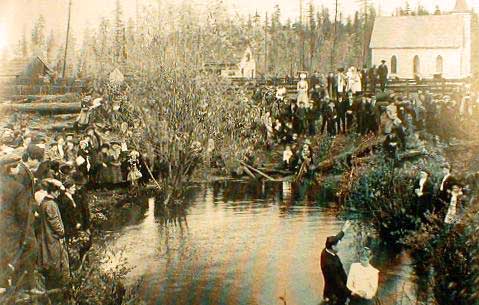 |
|
of the Battle Ground Christian Church |
In this rare photo owned by the Columbian newspaper and made in 1907, preacher Frank Jones is baptizing a lady into Christ in Woodin Creek. The Battle Ground Christian Church building can be seen in the background.The members of the church are looking on. Notice the high respect for the church assembly as reflected in their dress.
Stone/Campbell churches, with a goal of being like the church in the Book of Acts, immerse those who make the decision immediately because they see it as part of the salvation process. To examine this teaching in detail, see the 13 panel Action presentation.
Battle Ground Christian Church Ida Junel Brown Ornsdorf died in 1915 and the funeral service was conducted at the Battle Ground Christian Church by the famed A. D. Skaggs, retired at Vancouver. Mr. and Mrs. Ornsdorff are buried at the Elim Lutheran Cemetery near Brush Prairie.
The Battle Ground Christian Church grew rapidly and soon added to their original building. As the years past, the church invited the Methodist Church to merge with them.
Hayes Map
The community of Hayes was once located about four miles east of Woodland on Hayes Road. Named after President Rutherford B. Hayes, the Post Office was established in 1876, the same year Hayes became president. But the Gardner Cemetery was not established until 1891. Several members of the Gardner family were Postmasters during its existence.
The contact person for the church in 1892 was J. B. Carmine. He reported 10 members that year. The church probably met in a local school building. Among the early members may have been Emmet Everett Kent, Dirk Kroon and Viola Wills Patrick (mother of the late Jess Wills). Each is buried in the Gardner Cemetery.
Like many small country congregations, it probably dissolved after cars became available and the Woodland Christian Church was formed in 1913. The Hayes post office was also discontinued in 1913.
Hockinson Map
The original name for this area was Eureka. a Greek word meaning 'I have found it.' The early settlers were Finns and Swedish speaking Finns from the Aaland Islands. Ambrosius Hakanson was the first postmaster in 1884. His name was anglicized to the present spelling and the town was named for him.
Hockinson Christian Church
A Christian Church is also in the history books for Hockinson, five miles southeast of Battleground on 182 Avenue. The 1962 Centennial booklet of the Hillsboro, Oregon Christian Church says their preacher, R. L. Shelley, preached for the church in Hockinson, Washington during September of 1896 and that 45 members were added to the church.
This matches precisely with stories in the Vancouver Independent newspaper -- the Eureka Etchings column. It reported a revival conducted by "Rev. Shelley of Oregon" and that Mrs. Ida Ornsdorff was baptized about September 14, 1896.
Other reported immersed by the September 24 and October 1 issues were: Mrs. Adkins, Miss Atkins, Mr. Jesse Brooks, Otto and Ivan Brown, Mr. H. Bunch, Maud Clapp, James Goodnight, Mrs. Hungle, Miss Mand Love, Mr. and Mrs. Lee Morgan, Misses L., M, and Ray Morgan, G. Olsen, Miss Agusta Robinson, Mr. and Mrs. Robinson, Miss Esther Skersiedt, Mrs. H. M. Smith, O. (or G.) Rambo, Winnie Ward, and Miss Hilder Watson. All of these were baptized in Morgan Creek, one-half mile north of the Eureka School.
A building was begun in 1905 "north of the school on the same side of 182nd Avenue." Arthur C. Vail was the minister in 1907.
The building was sold in 1917 to the Congregational Church (which no longer exists under that name). It is now the Hockinson Community Church. Today there is an a capella Church of Christ nearby at 16401 NE 182 Avenue.
These two congregations (Battle Ground and Hockinson) did not last long and in the case of one merged back to the denominational world its leaders had once left. This should be a stern lesson for present day church leaders. It is constantly necessary to carry on a teaching program so members of the congregations understand the unique nature of the church of the New Testament.Washougal Map
Originally named Parkers Landing, Washougal itself is from an Indian name meaning rushing water. In 1914 it has 600 residents.
The Christian Church here has left no records. This photo is of its building located at what today would be 24th and B Street, also known as Ash and 2nd. The property was just west of the intersection on 2nd or B Street and on the south side of B Street.
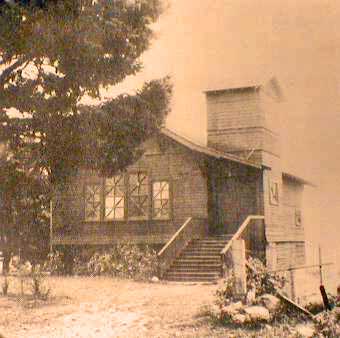
Washougal Christian Church
about 1914, at 24th and B.The photo shows a building that is on a 1914 map, so it was built before that. It was heated with a stove in the basement and had electric lights. The location was about three miles from the Camas Christian Church that was built in 1912.
According to a 75th Anniversary document from the Camas Christian Church, the Washougal congregation began in the spring of 1910 from the efforts of R. J. and Anna Blair.
Martin Snoey, historian of the Camas Christian Church, believes that Washougal was the earliest congregation of the Christian Churches in the twin-town area and that a number of members actually came from Camas. Eventually they left Washougal to begin services closer to home. At this time, preacher J. W. Baker was working with both groups.
The early families included S. T. Jones, T. H. Teal and J. P. Thomas.
The Camas-Washougal Historical Society has located an ad in the local newspaper for the Washougal Christian Church in 1945. We are guessing that the two congregations eventually went together and the records were lost for the Washougal Church. They are not in the possession of the Camas Church.
Camas MapView Camas, Washington Church - 26 seconds

The camas is a blue-flowering plant, considered a delicacy among the Indians who once lived here.
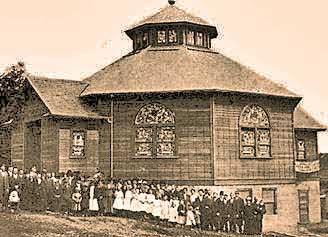
Camas Christian Church about 1918,
before the building was painted.
Link to a larger version.This congregation, also in Clark County and affiliated with the Disciples of Christ, was established in 1911 with 15 people. They were originally known as The First Church of Christ of Camas. Meeting in the Odd Fellows Hall at first, they built in 1912. The Sunday School program grew rapidly and soon attendance was over 100.
The hexagonal design for this church building was inspired by the design of Alexander Campbell's famous windowless, chairless study next to his home in Bethany, West Virginia*. The church is located at 404 NE 6th in Camas.
( * This is documented in the Camas-Washougal Post-Record of Feb. 24, 1987, Buyer's Bonus Section, page 6.)
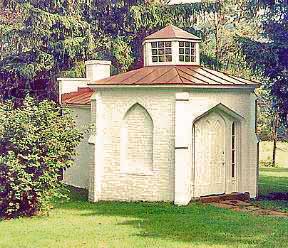
Campbell's Study in Bethany, WV. Camas was laid out as a new town in 1883 and the next year C. H. Hodges, a former Bethany College student, taught school there. Four denominations each used the newly-built Presbyterian meeting house once each month, but when there was a fifth Sunday, Hodges preached. Perhaps his work and influence set the stage for the birth of either the Washougal or the Camas Christian Church.
Among the first elders of the congregation was George W. Copley, father of Nellie Copley who attended the Minnehaha Church of Christ and served as forwarding secretary for B. L. Turner while he served the Lord in Pakistan.
The charter members included Charles Asher, R. J. & Anna Blair, Mrs. A. M. Blake, Nina Brown, Nora Brown, Fred Burlingame, Mr. and Mrs. O. C. Copley, Merl (or Myron) Copley, Mr. and Mrs. Thomas Craig, Mrs. G.W. Gaines, Mrs. Harris, Mr. and Mrs. O. C. Hughes, Mrs. Huycke, Mrs. Deborah Knapp, Mrs. A. D. McKever, and Mrs. Mary E. Oakley.
Next Chapter: Next Chapter or back to Pioneer Menu
To DOCHS 3/03

![]()
